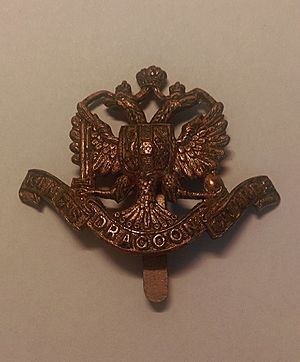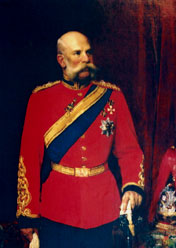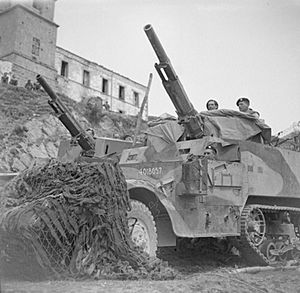1st King's Dragoon Guards facts for kids
Quick facts for kids 1st King's Dragoon Guards |
|
|---|---|

1st King's Dragoon Guards Cap Badge
|
|
| Active | 1685–1959 |
| Country | |
| Branch | |
| Type | Cavalry |
| Role | Royal Armoured Corps |
| Size | Regiment |
| Nickname(s) | Bland Dragoons, The KDGs, The Trades Union, The Kings Dancing Girls |
| March | Quick: Radetzky March Slow: The King's Dragoon Guards |
| Commanders | |
| Ceremonial chief | Emperor Franz Joseph I of Austria |
The 1st King's Dragoon Guards was a famous cavalry regiment in the British Army. It was first formed in 1685 by Sir John Lanier. The regiment was originally called the 2nd Queen's Regiment of Horse. This name honored Queen Mary, who was married to King James II.
Later, in 1714, its name changed to the 2nd King's Own Regiment of Horse. This was to honor King George I. In 1751, it finally became known as the 1st King's Dragoon Guards. The regiment used horses for fighting until 1937. Then, it started using light tanks instead. In 1939, it joined the Royal Armoured Corps. After fighting in the First World War and the Second World War, the regiment joined with another one in 1959. It combined with the 2nd Dragoon Guards (Queen's Bays) to form the 1st The Queen's Dragoon Guards.
Contents
History of the King's Dragoon Guards
Early Years of the Regiment
The regiment started in 1685. Sir John Lanier created it to help stop the Monmouth Rebellion. It was first called Lanier's Regiment of Horse. It was also known as the 2nd Queen's Regiment of Horse. This name honored Queen Mary, King James II's wife.
The regiment fought in many important battles. It was at the Battle of the Boyne in 1690 and the Battle of Aughrim in 1691. These were part of the Williamite War in Ireland. They also fought in the War of the Spanish Succession. Key battles included Battle of Blenheim (1704), Battle of Ramillies (1706), Battle of Oudenarde (1708), and Battle of Malplaquet (1709).
In 1714, the regiment was renamed the 2nd King's Own Regiment of Horse. This honored King George I. They fought again at the Battle of Dettingen in 1743. This was during the War of the Austrian Succession. In 1751, the regiment got its final name, the 1st King's Dragoon Guards. During the Seven Years' War, they made a brave charge at the Battle of Corbach in 1760. This charge helped save the army. They made another famous charge at the Battle of Warburg that same month. Later, they charged with great effect at the Battle of Waterloo in 1815 during the Napoleonic Wars.
The regiment also helped during the Indian Rebellion of 1857 in 1857. They fought at the Battle of Taku Forts (1860) in 1860. They also helped capture Peking during the Second Opium War. A small group from the regiment captured King Cetshwayo at the Battle of Ulundi in 1879. This was during the Anglo-Zulu War. The regiment also saw action at the Battle of Laing's Nek in 1881 during the First Boer War. They chased General Christiaan de Wet in 1901 during the Second Boer War.
The Austrian Connection
In 1896, something special happened. Emperor Franz Joseph I of Austria became the Colonel-in-Chief of the regiment. This was a great honor. At the same time, the double-headed Austrian eagle became the regiment's cap-badge. The regiment also started using Radetzky March as its special marching song.
To celebrate his 60 years as Emperor, Franz Joseph I created a special medal. Some of these medals were given to officers and soldiers in the regiment. A special helmet given to Emperor Franz Joseph I is now on display. You can see it at the Museum of Military History, Vienna.
Fighting in the First World War
When the First World War began, the regiment was in Lucknow, India. In November 1914, they arrived in France. They were part of the 1st Indian Cavalry Division. They fought on the Western Front.
The regiment saw action at the Battle of Festubert in May 1915. They also fought in the Second Battle of Ypres that same month. Another battle was the Battle of Morval in September 1916. In October 1917, the regiment returned to India.
The Third Anglo-Afghan War
The regiment stayed in India until 1918. In May 1919, Afghan troops took control of some wells near the border. The Afghan leader, Amir Amanullah, was asked to leave. But he sent more troops instead.
The regiment was called to action on May 6th. They were part of the British Indian Army's cavalry. They fought throughout the Third Anglo-Afghan War. They saw action at the Khyber Pass. On May 16th, at a village called Dakka, the regiment made a charge. This was one of the last times a British horse cavalry regiment ever charged in battle. It showed that the old ways of fighting were changing to new, mechanized ways.
The Second World War
The regiment took part in all the big battles of the North African Campaign. This included helping to free Tobruk in November 1941. The regiment used armored cars for scouting. They landed in Italy in September 1943. This was during the Allied invasion of Italy. They faced strong enemy resistance.
They were the first Allied unit to enter the city of Naples in October 1943. A writer named Norman Lewis said the King's Dragoon Guards were the first British unit in Naples. The regiment later fought in the Battle for Monte la Difensa in December 1943. They also advanced to the Gothic Line in late 1944.
After the Wars
After the Second World War, the regiment moved around. They were in Palestine in 1945. Then they went to Libya in 1947. In 1948, they were stationed in Northern Ireland.
In the 1950s, they moved to Germany. In 1956, the regiment went to Malaya. This was during the Malayan Emergency. They helped fight against rebels. They used armored cars and also fought on foot in the thick jungles. They were based at Johor Bahru. In 1959, the regiment joined with the Queen's Bays (2nd Dragoon Guards). Together, they formed the 1st The Queen's Dragoon Guards.
Regimental Museum
You can learn more about the regiment at its museum. The collection is on display at Firing Line: Cardiff Castle Museum of the Welsh Soldier in Cardiff.
Battle Honours
The regiment earned many special honors for its bravery in battle. These honors show where they fought and won. They fought in early wars, the First World War, between the wars, and the Second World War.
Notable Members of the Regiment
Many important people served in the regiment:
- William Pitt, 1st Earl of Chatham – He later became a Prime Minister of Great Britain.
- Banastre Tarleton – A cavalry officer during the American Revolution.
- Alfred Hutton – An author and expert swordsman.
- Francis Younghusband – A soldier, explorer, and spiritualist.
- John Doogan – He received the Victoria Cross, the highest award for bravery.
- James Lockhart Little – A rider who won a famous horse race, the 1848 Grand National.
|




